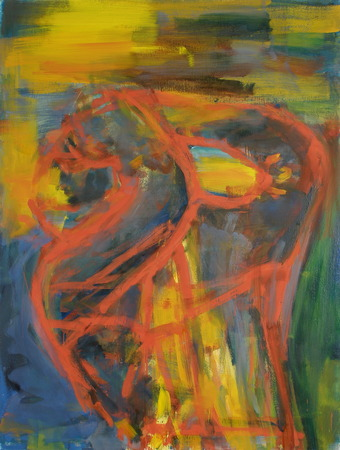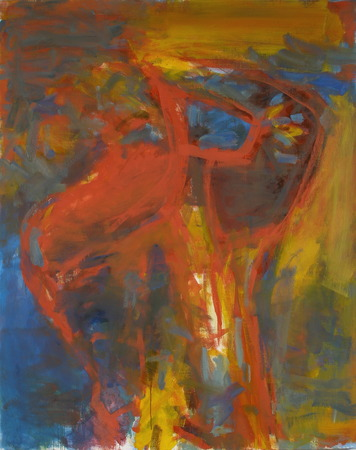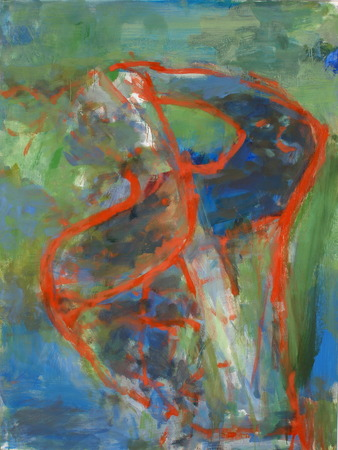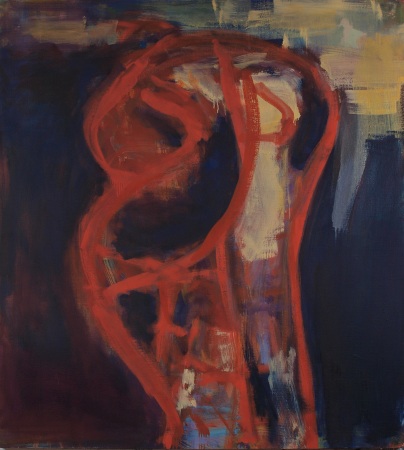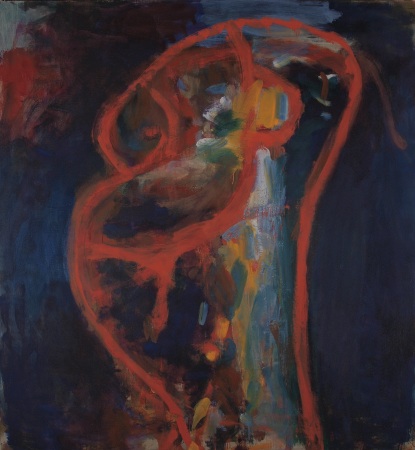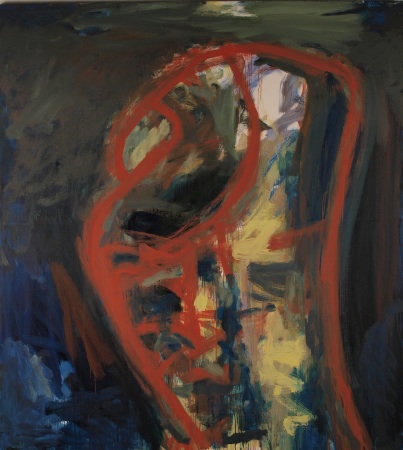LEX BRAES: RECENT WORK
Karen Wilkin
The first paintings by the Glasgow-born, peripatetic Lex Braes I saw were in a New York exhibition about ten years ago. They were sensual abstractions that seemed at once ambiguous and rooted in specific references, albeit specific references that appeared to resist identification, contradictory as that may sound. What was most interesting, these paintings refused to settle down. They remained slightly uncomfortable and a little puzzling, despite their harmonious palette and deft paint-handling, all of which held my attention. The series had its genesis - according to artist's witty, rather provocative explanations in a statement accompanying the exhibition - in his experience of landscape in several different parts of the world and in his sense of Scottish nationalism. This translated into richly layered expanses constructed with broad, transparent strokes of ochres and umbers; against these brushy grounds, economical clusters of thick, dull red lines fleetingly suggested particular configurations and/or pushed the space of the paintings around. Sometimes the strokes accumulated as opaque, sooty "continents" or opened out into diaphanous golden haze; at other times, the surface of the canvas seemed as earthy and dense as a cliff face, so that Braes' slow, deliberate drawing began to read the artifact of some vanished culture, like an abstract kind of cave painting pulled up to the light of day. (The neolithic red pigment of the lines reinforced the association.)
In one of the strongest of these pictures, a pair of unnameable red-bounded shapes drifted across a gestural field, one sliding out of the confines of the canvas. In another, notable for its happy adjustment of shape and drawing, a narrow loop of thick line stretched across the center. I was held by the tension between the paintings' frank celebration of the character of paint and their suggestion of not quite identifiable but clearly meaningful allusions - allusions that evaporated, like visions in dreams, just when they seemed about to yield up their significance. Did it help to learn, as we did if we read the artist's statement, that these images had their origins, respectively, in the shape of the kilt (and all its political implications) and in observed landscape forms? Not really. If anything, identifying the specific triggers for Braes's configurations restricted the multiple possibilities for association that his distilled imagery seemed to demand and that his suggestive sweeps and strokes encouraged. Yet spontaneous and improvisatory as Braes's paintings were, their basis in things seen and experienced clearly strengthened them, like a sturdy armature. I suspected, on that first encounter, that this connection with actuality or at least, with the phenomena of the real world, created limits for the artist to work against, something that he appeared to find stimulating. But I also suspected - prodded, in part, by that intelligent, unexpected artist's statement - that the abstractness of Braes's works did not come about because he "disguised" his references; rather, it seemed the natural result of ignoring the anecdotal or literal characteristics of whatever had triggered the painting in the first place in order to seek out its conceptual or metaphorical underpinnings.
In the ensuing decade, I've had many more opportunities to see Braes's work, in and out of the studio, and I've discovered that my early suspicions were well founded. Braes has a polyglot background, as an artist; his aesthetic education includes a solid grounding in perceptual realism, a fascination with minimalism, an immersion in the most provocative aspects of conceptual art under the tutelage of some of its most inventive practitioners, and close study of Old Master drawings. His practice is deeply informed and enriched by these multivalent interests. Although his work remains far from conventionally referential, Braes describes himself, at present, as "a painter from perception even while my improvisatory meanderings away from the subject's representational reality may obfuscate this fact."
Over the past decade or so, his paintings' visible allusions to the world around him and even their indefinable tone of "Scottishness" - perhaps subliminally evoked by a palette of misty earth tones, silvery blue-greys, creamy tans, dull greens, and mineral red - seem to have become at once clearer and less specific, or perhaps more accurately, more all-embracing. While Braes's canvases seem at first acquaintance to be, as they have long been, ruminations on the character of paint - its viscosity and responsiveness, its ability to be both dense and transparent, luminous or opaque - they quickly yield glimpses - now unequivocal, now almost imperceptible - of recognizable images. These include, among other things, oversized heads, seated figures, landscape elements, his daughter, gesturing figures, Madonnas, and more, all conjured up by generously scaled drawing that captures the rhythm and essential qualities of a gesture or posture and distills it into economical lines, like the worn vestiges of more specific renderings. It seems perfectly logical that Braes should have spent some of his early years painting in what he describes as "a rigorously objective manner." This lasted, he says, for about a year or two, "but the paint began to demand more." These early works were the ancestors of a group of later, confrontational, broadly handled, relatively straight forward paintings of architecture, figures, and landforms, images that were eventually subsumed into a more painterly, less overtly referential language of luminous, layered swipes and sinuous line.
In his recent work, Braes's drawn configurations are legible to the point of insistence, yet they threaten to evaporate under scrutiny, like dream images or imperfect memories. We interpret a richly inflected cage-like form as the upper part of a tense figure with upraised, tightly bent arms, but at the same time, we are made equally aware of how slightly histrionic pose is at once contradicted by the severity of Braes's use of color and tone and heightened by the expressive qualities of his fluent touch and lush paint-handling. The enigmatic image subsides into the surrounding sea of modulated, close-valued color just when it seems about to yield up its significance. Similarly, a draped, seated figure is revealed to be a Madonna, yet lapses back into being simply a draped, seated figure, momentarily coalesced out of ample sweeps of subdued color and some bold incisive drawing that defines the volume between torso and legs. Even at their most pared-down, Braes's short-hand references are so convincing that we begin to suspect that even his choice of colors has precise associations for him -- not that it's necessary to know what these might be; the paintings certainly don't ask to be deciphered.
It's also true that once we do decode Braes's covert allusions - when the cage-like configuration resolves itself as a figure in some unspecified emotional state or we suddenly interpret another complex set of large linear strokes as allusions to a thrown-back, giant head - his paintings' considerable seriousness and presence seem intensified. Yet even if Braes's work gains from its firm foundation in direct experience, no amount of covert (or overt) reference would be of any consequence, if he didn't also respond with such vigor to what he calls "the demands" of his chosen medium. Part of what makes these works so compelling is their author's ability to make paint and touch and line and placement expressive in their own terms, independent of whatever images, vestigial or explicit, that they suggest. Still it's equally clear that however satisfying Braes's paintings may be as paintings - in terms of their formal richness or their ability to evoke their nominal subjects - he is in pursuit of other aims: something larger and more subtle than either painterly accomplishment or the inventive interpretation of a motif. "All the while I'm interested in the thing I'm perceiving," Braes says, "I'm interested in why I'm interested in or attracted to the thing, whatever it happens to be. This attraction is as much my subject as the object is. In other words, my paintings are from the first philosophically driven and/or morally driven, so merely rendering objective reality does not cut it for me."
I suspect that it would be impossible to answer the absorbing questions of why Braes is drawn to particular motifs in purely pictorial terms (without resorting to illustration, of a kind), but the mere fact that he asks himself why changes his paintings from reports on things seen or experienced into open-ended voyages of self-discovery. Even if we have not been told of the artist's private motivation, we can sense that there is more to Braes's work than meets the eye, at first viewing. His conviction that the visible elements of his paintings (whether those elements seem, according to our predilections, mainly "abstract" or mainly allusive) stand for something more than can be seen immediately helps to account for the intensity and assuredness of his most challenging paintings. Yet while the best of his work seems open to a wide variety of interpretations, it remains self-sufficient and impervious to obvious explanations. Nothing in a Braes painting, no matter how sure we are that we have cracked its visual code, is quite what it seems. His strongest works make us keep looking, if we wish to penetrate some of their secrets. They force us to question our assumptions and to examine our responses; they disrupt our sense of comfort at the same time that they delight the eye. That's a great deal.
Karen Wilkin
New York, November 2009
